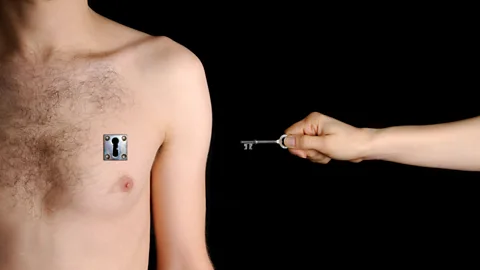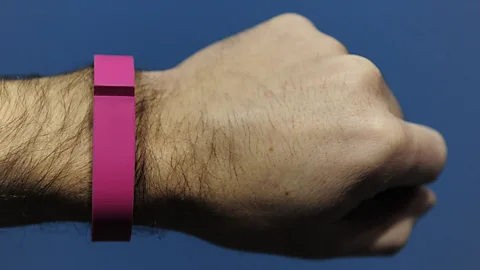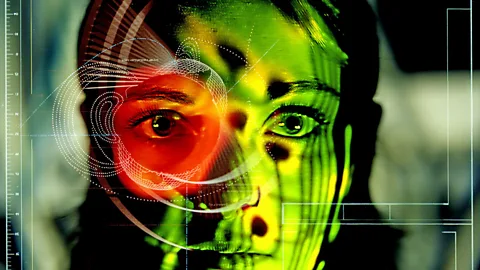Wearable technology: Who knows your body’s secrets?

Your sex life, illnesses, even your fertility – new tech can track what our bodies are up to, but some people may be revealing more than they realise, says Jacob Ward.
Jeff started having sex at two in the afternoon. Apparently it lasted a few hours, and he burned a total of 347 calories. We know because these facts were available to anybody on the internet, and it wasn’t clear if he realised.
Jeff was wearing a Fitbit, a web-connected wristband that measures exercise intensity so users can track the calories they lose. In 2011, this data also happened to be displayed on a website available to search engines, so many wristband wearers who had labelled their sex lives as exercise had the details broadcast to the world.
While the company behind Fitbit quickly plugged such leaks, the case served as an intriguing reminder that connecting our body’s activity to the internet can have unforeseen results.
A variety of wearable technologies and medical devices now monitor how much you weigh, what you eat, how fertile you are – and crucially, much of that information can be shared with your social network, doctors, companies, or even complete strangers. Our physical activity is becoming virtual. While there are many benefits promised by putting your vital signs online, the question is how much of your body’s secrets would you be willing to share?

One of the first people to connect their daily activity to the internet was Steve Mann. Widely regarded as the pioneer of wearable computing, he created a series of backpack-mounted computers in the 1980s, which included video cameras and a heads-up display mounted over one eye, like a precursor to Google Glass. By the mid-1990s, Mann had created a portable wireless camera that he wore 24 hours a day, seven days a week. Called the Wearable Wireless Webcam, he streamed his day-to-day activities online, and its benefits soon became apparent, when Mann filmed a hit-and-run accident, with the footage later used to identify the guilty party.
Mann’s innovations focused more on how he engaged with the outside world, but the principle of wearing technology and logging activities paved the way for devices that track your body’s functions, before presenting – or exposing – them to the world.
For example, devices like Fitbit and Nike’s FuelBand record people’s motion and then send that information wirelessly to a website so they can keep track of calories burnt and so on. Some share it on Facebook or other social media sites. For many users there’s a clear allure – many so-called lifeloggers claim it improves their health and fitness, for example.
Wearable technology can also help us be more aware of our bodies in other ways. Wireless medical devices have made the world a lot smaller for those with chronic illnesses – for example, wireless blood glucose monitors and pacemakers allow doctors to remotely monitor their patients.
Or take a technology called Duofertility, a combination of skin patch and wireless monitor that allows its maker’s fertility consultants to remotely determine the most fertile days of a woman’s cycle, and advise on the best time to conceive. The company behind Duofertility claim its trials had the same success rate as an IVF cycle, which can be more expensive.
Wisdom of the crowd
In the future, some predict we might share even more. Researchers writing recently in the Journal of Medical Internet Research foresee patients using wireless medical devices and activity trackers to ‘crowdsource’ information and diagnoses about their body. This is already happening with crowdsourcing diagnostic websites such as PatientsLikeMe and CrowdMed, which allow people to share their mystery symptoms. PatientsLikeMe are already trialling data integration from wearable and implanted health devices. This is a future where, by bringing our bodies’ inner workings online, we could tap into the wisdom of crowds to identify mystery ailments.
However, there may also be risks ahead – in particular, if people reveal much more than intended. Who should have access to your body’s information? For example, imagine health insurers’ delight when their customers start to upload – intentionally or otherwise – their movements, sexual activity, eating habits, or drug use. Do you go skydiving? How much red meat did you eat last week? How many sexual partners have you had? Insurers with this knowledge could charge you more, or simply refuse to cover you. Indeed, some are already concerned about health insurers misusing personal health information – it’s one reason why the UK National Health Service has decided to delay plans to share summarised patient records on an online database.

Another consideration is that no body exists in isolation. Your genes are the genes of your siblings and parents, for example. Some are now sharing the results of their genetic profiles online, on ancestry websites and forums, but there’s the possibility that they might mistakenly share information about somebody else who wanted to remain private. As science writer Virginia Hughes wrote: “Searching your genetic ancestry can certainly be fun… But the technology can just as easily unearth more private acts – infidelities, sperm donations, adoptions. Family secrets have never been so vulnerable.”
Broadcasting your body’s workings on the internet will inevitably be a fine balance between risk and reward. The returns for this technology could be significant, making us healthier and happier, but we may also have to accept our bodies becoming more public than ever before.
